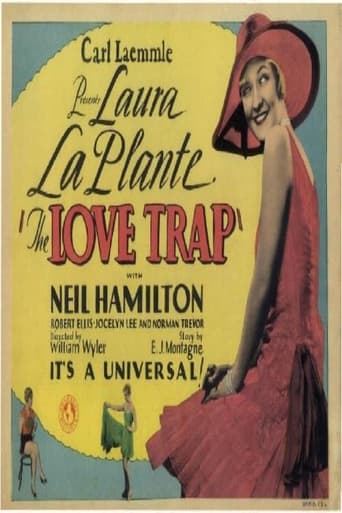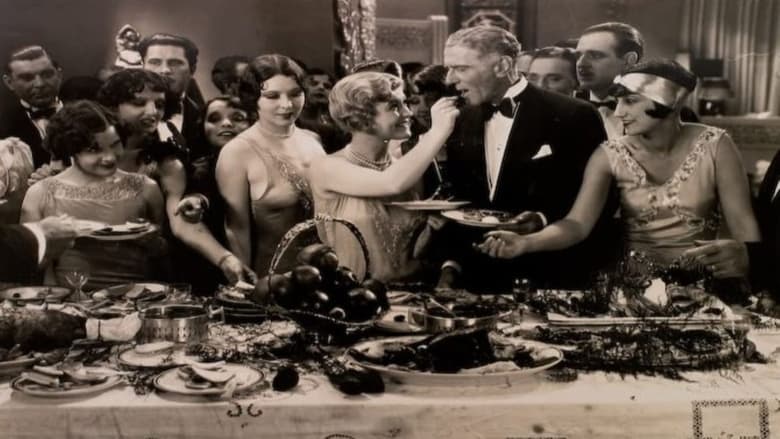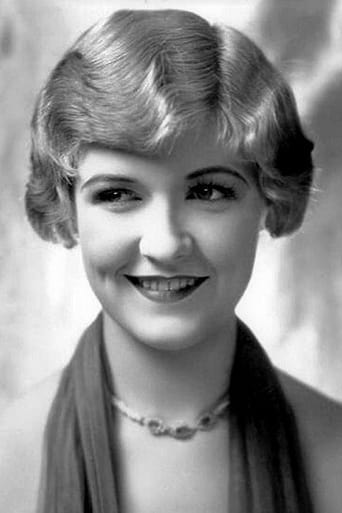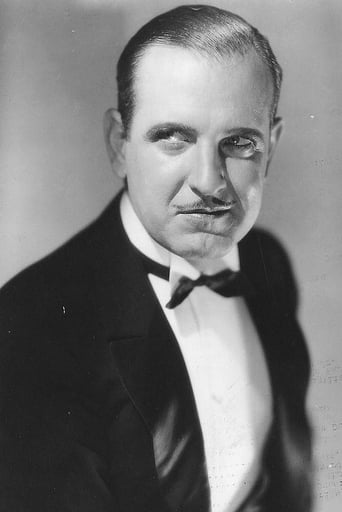The Love Trap (1929)
A chorus girl loses her job and thus the room she owes back rent on, and ends up being rescued from the street by a dashing rich man. But his family isn't over-accepting of chorus girls joining their family.
Watch Trailer
Free Trial Channels
Cast


Reviews
It's fun, it's light, [but] it has a hard time when its tries to get heavy.
It's hard to see any effort in the film. There's no comedy to speak of, no real drama and, worst of all.
Your blood may run cold, but you now find yourself pinioned to the story.
A film of deceptively outspoken contemporary relevance, this is cinema at its most alert, alarming and alive.
Another movie with a poorly conceived, second-string plot, The Love Trap (1929), stars a none too flatteringly photographed Laura La Plante and a quite presentable Neil Hamilton. Admittedly, director William Wyler handles the early scenes with a bit of style, but when the scriptwriters throw in the towel and the good-guy hero suddenly acts like a cluck, and the producer starts pulling in the purse strings, director Wyler's lavish staging and agreeable handling take a run-out powder too. The movie is available in its full 71-minutes silent version in a good print from Grapevine Video, along with a somewhat crudely animated but occasionally imaginative Fleischer cartoon, Ko-Ko's Reward (1929) in which the on-screen Max has a go at blending live action with animation.Be prepared! "The Love Trap" itself is still a must-see movie, even though it is fatally flawed.
The plot of this deceptively overlooked little trifle is the usual nonsense about a sweet young lass whose path crosses that of one of those personable young millionaires with entirely honourable intentions you find behind every corner in the silents, only to be entirely falsely suspected of being a gold-digging little hussy by his disapproving family. But 'The Love Trap' proves fascinating historically both as a relic of the "part-talkie" era and for its adroit staging by the up-and-coming young William Wyler feeling his way towards his mature style.The first two thirds of this fluff has attractive performances in the leads by Laura La Plante and Neil Hamilton, while Wyler is already visibly attempting to find ways of extending the boundaries of the cinema screen through frequent use of pans and attempts at composition in depth. In his talkies Wyler abandoned the pans, which tend to jar at times, but with the great Gregg Toland behind the camera eventually came second only to Orson Welles as the 1940s' master of deep focus composition in 'The Best Years of Our Lives' (1946), which veteran cameraman Gilbert Warrenton had done his best to achieve in 'The Love Trap' with the limited resources then at his disposal.Then suddenly everybody starts talking! The early scenes had all carried a Vitaphone soundtrack, and 'The Love Trap' had evidently started life as a silent, since there are scenes in which people speak dialogue which the makers haven't bothered to caption, as they'd presumably decided the film was going to go into release as a part-talkie and thus elected to keep titles to the minimum in scenes where the audience would be able to get the gist without them.At this point the film seems on the verge of turning all serious on us, but happily opts instead for saucy pre-Code farce, in which Miss La Plante - mostly dressed only in her scanties - effortlessly and charmingly leaps the daunting hurdle of suddenly starring in a talkie.
This is a transitional film--one that is partly silent and partly a talking picture. This was common during the late 20s in the US and all the way up into the early 1930s throughout the world. So, although I have heard "The Jazz Singer" (1927) referred to as the first 'talkie', it only had a few talking and singing portions. A few other such films are "The Mysterious Island" (1929) and "Blackmail" (1929), but the number of such films is significant. Quite often, silent films were held from circulation and a few talking segments were added so that the film could be advertised as a talkie! "The Love Trap" clearly was originally planned as a silent, but instead of one or two talking segments spread throughout the film, it begins silent and about midway through it, the film becomes a talkie.For the most part, it's a pretty ordinary film and is probably only on DVD today since it was an early film of the famed director, William Wyler. It is also interesting for two other reasons. First, it is very Pre-Code in its sensibilities--with scenes involving attempted sexual assault, a woman being patted on the butt and a lot of sexual innuendo. Now this is NOT to say it's a dirty film (as the lady is quite innocent) but if the studio had attempted to release the movie following the adoption of a toughened Production Code in 1934, it never would have been allowed without significant editing. Secondly, it stars an actor who was a HUGE star in the 20s up through the mid-1930s who is almost totally forgotten today. Neil Hamilton (known to a few as Commissioner Gorden from the 1960s "Batman" show) was a very handsome and popular leading man and I've seen several dozen of his films--and enjoyed them quite a bit. As for the leading lady, Laura La Plante, she was never that prolific as an actress but had a relatively successful, if undistinguished, career.The film begins with Miss La Plante getting tossed out of her job as a chorus girl. She's way behind in her rent and is in danger of being tossed out of her home. So, in desperation, she goes to a party with a friend to try to meet a man, but it turns out to be a wicked party and she snuck away--as she was not that sort of a girl. Then she returns to her flat only to see her belongings sitting out front in the rain. A nice rich guy comes by and sees her predicament and comes to her aid. Oddly (and only in a scene that you'll see in films or with guests from "The Jerry Springer Show"), the pair get married--knowing almost nothing about each other.A few days later, after the dust settles, the first problems in their quickie marriage develop. Hamilton's very snobbish family is not amused he married so quickly (very understandable) but they also are angry because she's so 'common'. Hamilton fails his new bride, as he allows his family to mistreat and mistrust her. Through a series of misunderstandings, they convince him that he married a skank--and the marriage appears to be heading for an annulment. La Plante does love her dopey hubby and concocts a rather clever (and funny) plan to win him back and keep his stupid relatives at bay.While today this film might seem pretty ordinary, for 1929 it's actually quite good--and manages to still be rather funny. Not a great film, but for a transitional movie, one well worth seeing--especially since it has a rather sweet ending--which old softies will no doubt enjoy.
Most of the movie is silent, with titles; just music on the sound track; and an acting style typical of later silents. At the climax, the actors start talking, though the sound track is mostly silent otherwise.The story is pleasant, but has been retold several times, so it will seem familiar if you've seen many 1930's pictures. Acting, sets and costumes are OK.








